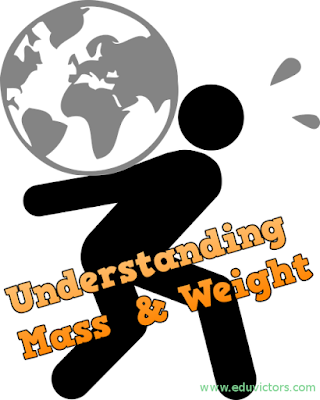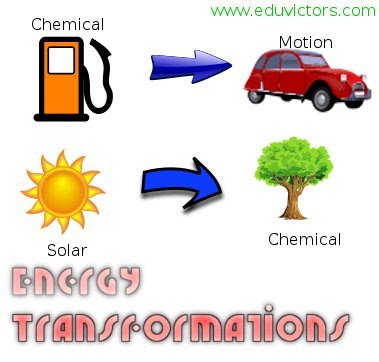Blog provides NCERT solutions, CBSE, NTSE, Olympiad study material, model test papers, important Questions and Answers asked in CBSE examinations. References to Educational Sites and resources.
Showing posts with label class9-science. Show all posts
Showing posts with label class9-science. Show all posts
Thursday 3 August 2017
Saturday 15 July 2017
CBSE Class 11 / 9 - Physics - Gravitation - Understanding Mass and Weight (#cbseNotes)
Understanding Mass and Weight
Physics - Gravitation
Mass and Weight
The quantity of matter in a body is known as mass of the body. Mass is quantitative measure of inertia. Mass is an intrinsic property of matter and does not change as an object is moved from one location to another. Weight, in contrast, is the gravitational force that earth exerts on the object and can vary, depending on how far the object is above the earth's surface or whether it is located near another body such as the moon. The relation between weight W and mass m can be written in one of two ways:
W = GMₑm / r²
W = mg
According to the Newton's second law,
Force = mass ✕ acceleration
or mass = force / acceleration
Mass is of two types :
i) Inertial mass
ii) Gravitational mass
1. Inertial Mass:
Ratio of the applied external force and the acceleration produced in the body is known as inertial mass,
mi = External force applied / Acceleration produced.

Wednesday 12 July 2017
CBSE Class 9 - Force and Laws of Motion - What is Inertia? (#cbseNotes)
What is Inertia?
CBSE Class 9 - Force and Laws of Motion
 |
| Let's move the rock! |
Inertia
It is inherent property of all bodies, by virtue of which it resists or opposes any change to it's present state of rest or of uniform motion. It varies directly as mass of the body.
Inertia of a body is of three types:
① Inertia of rest
It is in ability of a body to change by itself or if state of rest. This means a body at rest remains at rest and cannot start moving on its own.
Friday 16 June 2017
CBSE Class 9 - Physics - Chapter - Force and Laws of Motion (Worksheet) (#cbseNotes)
Force and Laws of Motion
(Worksheet)
Q: Fill in the blanks with suitable choice given in brackets.
1: The product of mass and velocity of a body is called __________. (momentum/force)
2: The property by the virtue of which an object tends to remain in the state of rest or of uniform motion unless acted upon by some force is called __________. (impulse/ inertia)
3: The SI unit of _________ is kilogram meters per second i.e. kg m/s (momentum/ force)
4: Momentum is a _________ (scalar/ vector) quantity and is directed along the __________ (direction/ magnitude) of velocity.
5: The total momentum of the bullet and the gun before firing would be _________ (zero/ positive / negative) because both of them ar at rest.

Thursday 11 May 2017
CBSE Class 9 - Physics - Motion - Assignment Sheet (#cbseNotes)
Physics - Motion
Class-IX
Assignment Sheet
Q1(MCQs) : Choose the correct option from choices given.
ⅰ A particle is moving in a circular path of radius’ r’. The displacement after half a circle would be
(a) Zero
(b) π × r
(c) 2r
(d) 2 × π × r
ⅱ The numerical ratio of displacement and distance of a moving object is
(a) always greater than 1.
(b) always equal to 1.
(c) always more than 1.
(d) equal or less than 1.
ⅲ An object has moved through a finite distance
(a) its displacement must be equal to the distance moved by it.
(b) its displacement must be positive .
(c) its displacement is less than the distance moved by it.
(d) Displacement may be zero.

Friday 28 April 2017
CBSE Class 9 - Science - Unit Test Paper (2017-18) (#cbsepapers)
CBSE Class 9 - Science Unit Test Paper (2017-18)
Chapters Covered In Unit Paper:1. Straight Line Motion
2. Cell - Fundamental Unit Of Life
3. Matter and Its Surroundings

Friday 24 March 2017
CBSE Class 9 - Chemistry - MATTER IN OUR SURROUNDINGS (Worksheet) (#cbsenotes)
MATTER IN OUR SURROUNDINGS
Based on Class 9 - Chemistry NCERT Chapter
(Worksheet)
Fill in the blanks
① The process of converting solid into liquid is called _________.
② __________ is the process in which the liquid phase changes to gaseous phase at a constant temperature and constant pressure.
③ The amount of a water vapour present in air is called__________.
④ ________ is the reverse process of evaporation.

Tuesday 21 March 2017
Thursday 16 March 2017
Sunday 12 March 2017
Sunday 26 February 2017
CBSE Class 9 Chemistry - Questions based on Mole Concept (#cbsenotes)(#class9SA2Chemistry)
Questions Based on Mole Concept
CBSE Class 9 Chemistry
Q1: Fill in the blank.
The mole (mol) is the amount of a substance that contains as many elementary entities as there are atoms in exactly ________ of C₁₂
Answer: 12g or 12 grams.
Q2: I owe you 1 mole of rupees. How many rupees do I have to pay for you?
Answer: 6.022 × 10²³ rupees.
Q3: Is mole a unit?
Answer: No, it is a large constant number called Avagadro's constant (N) = 6.022 × 10²³
Q4: Atomic mass of Na is 23u. What is the mass of 1 mole of Na atoms? Is there any name for this?
Answer: 23g. It is also called the molar mass of Na atoms.
Q5: Atomic mass of oxygen(O) is 16u. What's its molar mass?
Answer: 16g.
Q6: What is the molecular mass of Water molecule (H₂O)?
Answer: Atomic mass of H = 1u
The atomic mass of O = 16u
The molecular mass of H₂O = mass of 2 atoms of H + mass of 1 atom of O
= 2 × 1u + 16u
= 18u
Q7: What is the molar or gram molecular mass of water?
Answer: Molecular mass of Water (H₂O) = 18u
Gram molecular mass = 18g or 18 grams
Q8: How many moles will be in 45g of water(H₂O)?
Answer: Molecular mass of H₂O = 18u
Mass of 1 mole of H₂O = 18g
No. of moles in 45g of H₂O = 45 ÷ 18 = 2.5 moles
Q9: How many atoms of Hydrogen are there in 2 moles of water?
Answer: 1 molecule of H₂O has H-atoms = 2 atoms
1 mole of H₂O has H-atoms = 2-mole atoms
2 moles of H₂O has H-atoms = 2 × 2 = 4 moles of atoms
= 4 × 6.022 × 10²³
= 24.088 × 10²³
= 2.4088 × 10²⁴ H-atoms
Q10: How many grams of SiO₂ are present in 0.8 mol? (molecular mass of SiO₂ = 60.1u)
Answer: Molecular mass of SiO₂ = 60.1u
1 mole of SiO₂ = 60.1g
0.8 mol of SiO₂ = 60.1 × 0.8 = 48.1g
Q11: Under standard temperature pressure conditions, what is the volume of 1 mol of gas?
Answer: 22.4 litres or 22.4l
Q12: How many mol of CO₂ (carbon dioxide) are present in 55.5 L ?
Answer: 1 mol of CO₂ = 22.4 l
55.5 litres contains = 55.5/22.4
= 2.48 mol of CO₂
Q13: What will be the mass of 12.044 × 10²³ molecules of O₂?
Answer: Molecular mass of O₂ = 2 × 16u = 32u
∴ 1 mol of O₂ = 32g
⇒ 6.022 × 10²³ O₂ molecules have mass = 32g
12.044 × 10²³ molecules of O₂ = 32 × 12.044 × 10²³ / (6.022 × 10²³)
= 32 × 2
= 64g
Q14: Calculate the mass of glucose in 2 × 10²⁴ molecules. Molecular mass glucouse is 180u
Answer: Molecular mass of glucouse = 180u
Gram molecular mass of glucouse = 180g
⇒ 1 mole (6.022 × 10²³) molecules = 180g
2 × 10²⁴ molecules will have mass = 180 × 2 × 10²⁴ / (6.022 × 10²³)
= 180 × 2 × 10 / 6.022 = 597.7 g
Q15: Write formula to calculate Number of moles
(a) of monoatomic substance, if its mass is given
(b) of a molecular substance, if its mass is given
(c) of a monoatomic substance, if number of atoms are given
(d) of a molecular substance, if number of molecules are given
Answer:
(a)
| No. of moles = | mass |
| atomic mass |
(b)
| No. of moles = | mass |
| molecular mass |
(c)
| No. of moles = | no. of atoms |
| 6.022 × 10²³ |
(d)
| No. of moles = | no. of molecules |
| 6.022 × 10²³ |

Tuesday 14 February 2017
Thursday 2 February 2017
CBSE Class 9 -Science - Natural resources (Worksheet - Important Terms) (#cbseClass9Notes)
Natural Resources
Worksheet
Important Terms
☛Following are the statements that define specific terms related to Natural resources. Identify the terms and fill in the blanks.
1. The outer crust of the Earth.
______________
2. The region which includes all the earth's liquid water, frozen water and small amounts of water vapor in the earth's atmosphere.
_____________________
3. The mass of air surrounding the Earth.
_____________________
4. The life-supporting zone of the Earth where the atmosphere, hydrosphere and lithosphere interact and make life possible.
_____________________

Tuesday 3 January 2017
CBSE Class 9 - Science - Structure Of Atom (Question Bank) (#CBSENotes) (#CBSEClass9Science)
Structure Of Atom
(Question Bank)
Questions Based on Class 9 NCERT Science Chapter
Q.1: Define atomic number.
Q.2: What is an electron? Who discovered it?
Q.3: Name the particles which determine the mass of an atom.
Q.4: Study the composition of the two nuclei of two atomic species L and M
L = protons 20, neutrons 20
M = protons 18, neutrons 22
Give the relation between the two.
Q.5: Write the formula for calculating the maximum number of electrons in an orbit.
Q.6: Name the particles that have no charge and their mass is equal to that of proton. Who discovered these particles?
Q.7: What is charge/mass ratio of an electron?
Q.8: What is the valency of oxygen [Atomic number of oxygen=8]?
Q.9: Write the notation of an atom ‘X’, if the mass number is A and the atomic number is Z.

Tuesday 20 December 2016
Class 9 - Science - SOUND - Question Bank (#CBSENotes) (#CBSEClass9Notes)
SOUND
Question Bank
Following questions have been asked in previous CBSE examination papers.
Q 1: Define frequency of a wave.
Q 2: Give a relation correlating sound velocity with its frequency and wavelength.
Q 3: What is SI unit of frequency?
Q 4: What is the true meaning of amplitude of a longitudinal wave?
Q 5: How is frequency of a wave related to its time period?
Q 6: On what factors does the loudness of a sound depend?
Q 7: Which sound has higher energy, a loud sound or a soft sound?
Q 8: On what factors does speed of sound in a medium depend?
Q 9: Define echo.

Tuesday 13 December 2016
CBSE Open Text Based Assessment (OTBA) for classes IX & XI, 2017 is Available
Open Text Based Assessment (OTBA)
For classes
IX & XI 2017
Available Now
OTBA Material for Class 9 and Class 11 for this session (2016-2017) is available at CBSE website. Here are the links to download the pdfs.
Open Text Material for Class IX
Subject- Hindi
Mathematics - English - Hindi
Science - English - Hindi
Social Science - English - Hindi

Thursday 8 December 2016
CBSE Class 9 - Science -Work Energy and Power - Question Bank
Work Energy and Power
Question Bank
Here is the compilation of questions asked in CBSE Examination papers in last five years.
Q1: Is it possible that a body is displaced and yet its work is done is zero? If yes write an example?
Q2: If the net work done on a particle is zero, is it possible the particle has uniform speed? How?
Q3: A body is moving on a straight road against a frictional force of 5N. After travelling a distance of 1.5 km he forgot to take the correct path at a roundabout of radius 100m. He moves the circular path of 1½ cycles then he moves forward up to 2km. Calculate the work done by him.
Q4: A force of 7 N acts on an object. The displacement is, say 8 m, in the direction of the force. Let us take it that the force acts on the object through displacement. What is the work done in this case?
Q5: When do we say that work is done?
Q6: Write an expression for the work done when a force is acting on an object in the direction of its displacement.
Q7: Define 1J of work.
Q8: A pair of bullocks exerts a force of 140 N on a plough. The field being ploughed is 15 m long. How much work is done in ploughing the length of the field?
Q9: What is the kinetic energy of an object?
Q10: Write an expression for the kinetic energy of an object?

Sunday 4 December 2016
CBSE Class 9 - Science - Work Power and Energy (ENERGY TRANSFORMATIONS) - Worksheet
ENERGY TRANSFORMATIONS
Worksheet
Give examples for the following scenarios of energy transformations. You may choose the answer(s) from the following list of wordssolar cell, turbine, mixer, fan, steam engine, automobiles, green plants, nuclear reactor, electric bulb, torch, electric bulb, microphone, loudspeaker, geyser, heater, car battery, inverter, LPG
| SNo. | Energy Transformation From ⟶ To |
Give Example |
|---|---|---|
| 1. | Mechanical ⟶ Electrical | _________ |
| 2. | Electrical ⟶ Mechanical | _________ |
| 3. | Electrical ⟶ Heat | _________ |
| 4. | Heat ⟶ Mechanical | _________ |
| 5. | Electrical ⟶ Light | _________ |
| 6. | Electrical ⟶ Sound | _________ |

Saturday 26 November 2016
CBSE Class 9 - Science - Floatation 7 Simple Numerical You Must Know
Floatation
7 Simple Numerical You Must Know
Answer:
Force = 200 N
Area = 10cm2 = 10 x 10-4m2
Pressure (P) = Force ÷ Area
P1 = 200 ÷ 10 x 10-4 = 2 x 105 Pa
New area = 50cm2 = 50 x 10-4m2
P2 = 200 ÷ 50 x 10-4 = 4 x 104 Pa
Change in Pressure = P1 - P2 = 2 x 105 - 4 x 104
= 1.6 x 105 Pa
Q2: A cuboid room has dimensions 50m x 15m x 3.5m. What is the mass of the air enclosed in the room if the density of air = 1.30 kg/m3.
Answer: Volume of room (V) = 50m x 15m x 3.5m = 2625m3
Density of air (d) = 1.30 kg/m3
Mass of air = V x d = 2625 x 1.30 = 3412.5 kg

Monday 14 November 2016
CBSE Class 9 - Science - CH 13 - Why Do We Fall iLL? (Important Differences)
Why Do We Fall iLL?
(Important Differences)
Q1: Write three differences between Personal Health and Community Health.
Answer:
| Personal Health | Community Health |
|---|---|
| 1. It is a state of physical, mental and social well being. | 1. It refers to maintenance, improvement of public health or environmental health. |
| 2. It focuses on individual's health. | 2. Its focus is on community health. |
| 3. Objectives are achieved by individual by observing personal and domestic hygiene. | 3. Objectives are fulfilled by providing safe water, medical facilities, proper sewage disposal etc. |
Q2: What are the important differences between symptoms and signs?
Answer: Please see answer in the previous post Q12.
Q3: Write differences between 'Being Healthy' and 'Disease Free'.
Q3: Write differences between 'Being Healthy' and 'Disease Free'.
Answer:

Subscribe to:
Posts (Atom)
